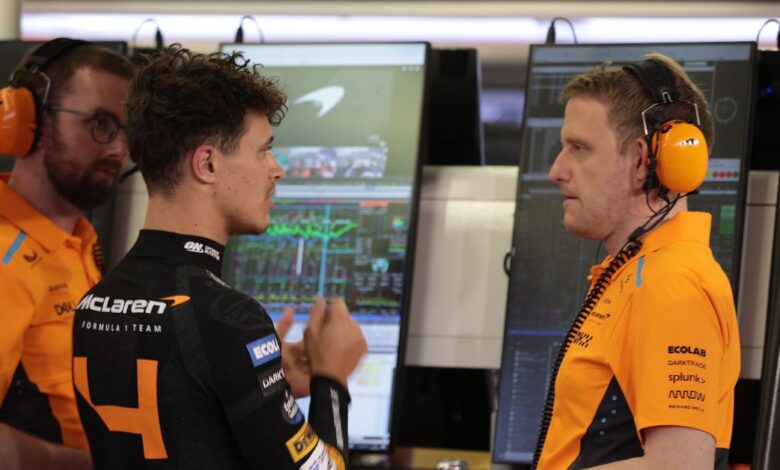F1 2024 pre-season testing: The first 2 days by the numbers

Just one day of pre-season testing remains ahead of the 2024 Formula 1 season. Before that final day gets underway, all ten teams are pouring through the data from the first four sessions, looking to learn as much as they can about their 2024 challengers.
Here at SB Nation, we are doing the same.
Let’s look at just some of what we have learned over the first two days of F1 pre-season testing.
2,451
In F1, speed is the name of the game.
However, that is not the full story when it comes to pre-season testing. Sure, you want to be fast. But you also want to be reliable. The more laps you can put in, the more confident you can be in your challenger heading into the upcoming campaign.
Before the third and final day of testing gets underway, 2,451 is where we stand in terms of the total number of laps run by the ten teams, combined.
Here is how those laps break down, by team and by day:
2024 F1 Pre-season Testing Lap Count
| Team | Day 1 | Day 2 | Total |
|---|---|---|---|
| Team | Day 1 | Day 2 | Total |
| Haas | 148 | 124 | 272 |
| Red Bull | 143 | 129 | 272 |
| Ferrari | 133 | 138 | 271 |
| Sauber | 131 | 135 | 266 |
| Aston Martin | 131 | 127 | 258 |
| Mercedes | 121 | 123 | 244 |
| VCARB | 115 | 128 | 243 |
| Alpine | 120 | 111 | 231 |
| McLaren | 129 | 87 | 216 |
| Williams | 61 | 117 | 178 |
| 1232 | 1219 | 2451 |
A few things stand out.
First, as we have talked about already Haas used the first two days of testing to focus on a flaw from last season: Tire degradation. New Team Principal Ayao Komatsu addressed that focus again on Thursday, following the second day of testing.
“Following on from yesterday, we continued our program on tire management and high-fuel performance. Nico drove in the morning, and even with the disruption he had that made the session a bit shorter, I think we got the basic answer we wanted,” said Komatsu in the team’s post-session media report. “We handed over to Kevin in the afternoon and he ran for five hours, and it was a pretty good session again. We got lots of good data and confirmation on what we wanted to run, so I’m pretty happy with the last couple of days. Tomorrow, because we’ve had two decent days, we may change the program a little but I’m looking forward to another productive day of testing.”
However, despite their emphasis on tire management and longer runs … Red Bull is right there next to them.
On the other end of the spectrum we find Williams and McLaren. Williams was undone by a few different problems on Wednesday, as Alexander Albon dealt with a fuel pump issue during the morning session and then a driveshaft problem cut Logan Sargeant’s afternoon session short. They rebounded with a better day on Thursday, but they are still at the bottom of the table.
As for McLaren, the team ran into some “small issues” according to Lando Norris, which cut down their lap totals in Thursday’s afternoon session.
We will wait to see if the lap numbers stay high on Friday, or teams shift their focus towards one-lap pace.
1.493
As you well know, 2023 was a dominant season from Red Bull. This was something we saw coming this time a year ago, as the RB19 looked to be the dominant package from the first day of pre-season testing in Bahrain last February.
To that end, it was Max Verstappen who topped the timing sheets on the first day of pre-season testing a year ago, posting a time of 1:32.837.
If you were hoping that Red Bull had taken a step back with their development of the RB20, you might be out of luck. Verstappen topped the timing sheets on Wednesday, with a time of 1:31.344.
Which is 1.493 seconds faster than his time from a year ago.
Of course, testing numbers always need to be taken with a grain of salt, and Verstappen could have been running a different program this year than he was last year when he posted that time.
But if not…
1:29.921
This represents the time posted by Carlos Sainz Jr., as the Ferrari driver topped the timing sheets on Thursday.
Behind him were Sergio Pérez with a time of 1:30.679 and Lewis Hamilton, with a time of 1:31.066.
However, there are a few things to keep in mind about this time. Sainz posted his lap on the C4 compound, while Hamilton and Pérez posted their times on the harder C3 compound. As Pirelli, the official tire supplier to F1, noted in their own post-session media report:
“However, it’s worth noting that, apart from the usual unknowns about fuel loads on fastest laps, Sainz set his time on a set of C4 tyres, while Perez and Hamilton were on the C3: the time difference over a lap between these two compounds is reckoned to be around six tenths.”
Also, for those wondering: The C3 will be the softest compound available at next weekend’s Bahrain Grand Prix. Pirelli has designated these three compounds for the season-opening race:
:no_upscale()/cdn.vox-cdn.com/uploads/chorus_asset/file/25299984/Screenshot_2024_02_22_at_7.23.19_PM.png)
So Sainz’s time, while impressive, needs to be taken with a grain of salt. Like everything during pre-season testing.
5
One more note on what we saw from Sainz, Hamilton, and Pérez on Thursday. Thanks to the brilliant minds at F1-Tempo — this will not be the last time they get a shoutout from me this season — we can compare each of their fastest laps from today’s session:
:no_upscale()/cdn.vox-cdn.com/uploads/chorus_asset/file/25299985/Screenshot_2024_02_22_at_7.25.33_PM.png)
Pérez’s lap is in the dark blue, Hamilton’s in the aqua, and Sainz’s in the red. As you can see, Sainz performed best in the second and third sectors, Hamilton had his best moments in a number of the turns, and Pérez certainly fared well on the long straight coming out of Turn 15, through the Start/Finish line, and into Turn 1.
Given the RB19’s strength with DRS a year ago, it is probably not a surprise to see that continue with the RB20.
But take note of the white dot on the above graph. At that point Pérez hit a top speed of 320 kph.
Which was 5 kph faster than Sainz’s top speed of 315.
Ominous, indeed.
0.125
It has been said before, but it bears repeating.
What a difference a year makes for McLaren.
Coming out of pre-season testing a year ago, the signs were worrying for McLaren. There was already talk of the team needing a big upgrade package later in the spring, and as we know they struggled in the early going. Lando Norris and Oscar Piastri combined for just 17 points over the first eight races of the season, as and Norris told me last April, they were just fighting for points.
Their fortunes changed over the summer when the upgrades to the MCL60 arrived, and by the year’s end they were fighting for, and winning podiums.
But to put some numbers behind just how much of a difference there is between last year and Bahrain and this year, consider 0.125.
Norris qualified 11th for the Bahrain Grand Prix with a lap time of 1:31.381.
His best time on Thursday? 1:31.256.
0.125 seconds might not seem like much, but given the likely difference in fuel loads between qualifying last year and the second day of pre-season testing this year, it is a ton.
To drive the point home consider this from F1-Tempo, showing Norris’ best lap from day two of testing last year, and day two of testing this year:
:no_upscale()/cdn.vox-cdn.com/uploads/chorus_asset/file/25300008/Screenshot_2024_02_22_at_7.40.45_PM.png)
His best lap back in 2023 on day two of testing? 1:35.522, over four seconds slower than this year’s best time. Comparing the two you can see that the MCL38 (in orange) was much better over almost the entire track than the MCL60 (in silver).
What a difference a year makes, indeed.



